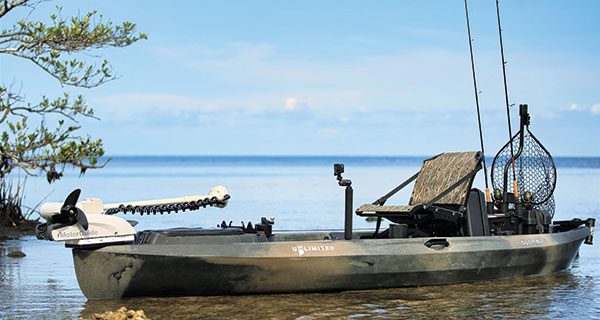Kayaking is one of the fastest growing outdoor sports, and there is a new feature making it even more attractive. That new feature is the introduction of outboard and electric motors that blurs the lines between a kayak and a boat, making kayaks a very versatile tool for hitting the waters.
For many years, the only way to propel a kayak was by paddle. Although a paddle kayak is by far the cheapest and fastest way to get on the water, it is also limiting. One of the biggest limitations on a paddle kayak is your arms are used to propel the kayak, so when fishing or doing other things, you are not able to paddle. This deficiency grows when fishing in waters with currents or wind. The other major limiting factor with paddles is speed. A paddle kayak is the slowest form of propulsion.
Kayak engineering now allows some kayaks to be fitted with pedal propulsion systems, outboard gas motors and bow or stern mount electric trolling motors. Most established kayak manufacturers are making direct bolt on motors or motor mounts. Motor companies like Newport Vessels and Motorquide actually make kayak specific motors. The Newport Vessels NK-180s is a brushless 24-volt motor that works on any kayak that can accept a stern mount bracket. Recently, I had the pleasure to run one and topped out over 5 MPH while towing two buddies in paddle kayaks behind me. The NK-180s is the best stern mount motor currently available for a kayak.
For a bow mount motor, the new Motorguide XI3 Kayak motor is amazing. This motor was specifically built for a kayak with a short 36-inch shaft to accommodate how low kayaks sit in the water and is 100% controllable by remote control. If you choose the Pinpoint GPS model, with the push of a button, you can anchor in current or wind, in seconds. Choosing between the two, the Newport Vessel motor can cover more range at a faster speed, while the Motorguide offers faster turning/maneuverability and pinpoint anchoring features.
Once you decide to go the motorized route, keep in mind the other components that are needed. First, you need to consider motor mounts and wiring. To highlight Nucanoe, their kayaks are all built with a square transom and can be paddled, pedaled, or equipped with a motor. For a motor, all Nucanoes are rated up to a 2.5HP outboard to really cover some water. Nucanoe also offers bow mount and transom mount adapters that offer a no drill application.
With an electric motor, the other main component is a battery. Standard deep cycle and car batteries will work, but on a kayak, weight is everything. Amped Outdoors makes lithium batteries that offer features such as half the weight and twice the power. I currently use an Amped Outdoors 100AH battery that will run my Motorguide XI3 all day and an Amped Outdoors 19AH battery for my graph and phone charger.
The last things to consider with a motorized kayak are transportation and registration. Motorized kayaks weigh significantly more than standard paddle kayaks. A truck or trailer is almost required. Once you place a motor of any type on a kayak, it now has to be registered with the appropriate state office. In Georgia it cost $25 to register a kayak with the GA DNR.
Take one word of advice and try before you buy, as any reputable shop will let you demo a kayak and motor before you buy. I always say no kayak or motor is perfect for everyone, and ensuring a perfect fit is essential to having fun on the water and staying safe.
William Reed is a Nucanoe National Pro Staff Writer. You can contact him at will@nucanoe.com or find him on InstaGram @wde_will
